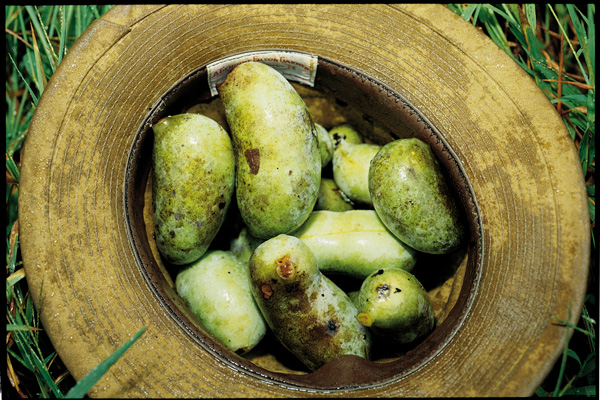
By Dan Zarlenga, Missouri Department of Conservation
Photo caption: Pawpaws, freshly picked, ripe, and ready to eat. It’s Missouri’s Top Banana!
Photo courtesy of the Missouri Department of Conservation
Did you know that you don’t have to travel to an exotic island to pick a fresh, tropical fruit? There’s one that grows right here in Missouri… and it’s even native to the state.
It does have an exotic sounding name, though. The pawpaw. You’ll find them not among sun-bleached sands or humid rainforests, but in the dense shade of moist, lowland slopes in the Show-Me State, or in ravines, valleys, and often along streams. You might also look at the base of wooded bluffs. Pawpaws grow in colonies that can be recognized as large shrubs or small trees with slender trunks and a broad crown of leaves. Some of the plants grow as high as 30 feet.
The fruits of the pawpaw are the largest that grow naturally in North America, and they truly share a relationship with their tropical relatives. Pawpaws grow in cylindrical shapes from 3-5 inches long. The pawpaw fruits start off as green, but as they ripen—which begins happening in September—they grow yellow. Sound familiar? They even take on the appearance of stubby bananas. Eventually, they will turn brownish purple as they grow riper.
But the similarity between pawpaws and bananas is more than skin deep. The fruit’s texture is soft and much like a firm custard. The taste of this Missouri native can be sweet and a bit tangy. Some liken the flavor to papaya and pineapple, with touches of banana or mango. Like bananas, it’s up to personal preference as to when is the best point in the ripening process to enjoy pawpaws. Do you prefer tangier or sweeter?
One thing is certain. If you want to have a taste of this “Ozark banana”, you’ll have to act fast to beat the wild critters! Squirrels, possums, raccoons, and even many birds, have also discovered the delicious treat and will devour them as soon as they are ripe enough. One good strategy for outfoxing wildlife is to pick the fruits before they are ready to eat and the animals take notice of them, then allow the pawpaws to ripen at home—much like bananas.
In addition to being tasty, pawpaws are quite nutritious. They pack more vitamins, minerals, amino acids, and food energy than many favorites like apples, peaches, or grapes. They also go great in desert recipes, such as cakes, pies, cookies, custards, and ice cream. The pawpaw is more than just a treat for the zebra swallowtail butterfly, however. Pawpaw leaves are essential food for zebra swallowtail larvae. We would never see these black and white, striped beauties without pawpaws.
If all this doesn’t impress you, consider that the pawpaw has also been named Missouri’s official state fruit tree. Surely, that makes it top banana!


